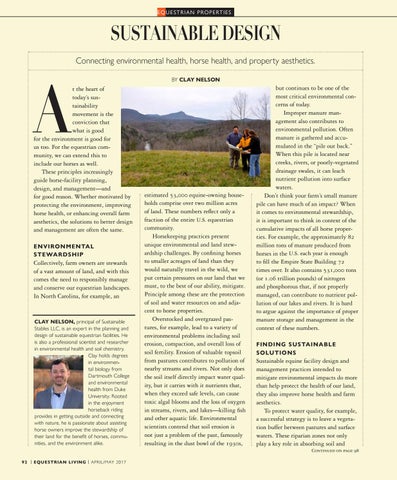E EQ Q U EUSETSRTI R A INA N P RPORPO E RT P E IRETS I E S
SUSTAINABLE DESIGN Connecting environmental health, horse health, and property aesthetics.
A
t the heart of today’s sustainability movement is the conviction that what is good for the environment is good for us too. For the equestrian community, we can extend this to include our horses as well. These principles increasingly guide horse-facility planning, design, and management—and for good reason. Whether motivated by protecting the environment, improving horse health, or enhancing overall farm aesthetics, the solutions to better design and management are often the same. E N V I RO N M E N TA L S T E WA RD S HI P
Collectively, farm owners are stewards of a vast amount of land, and with this comes the need to responsibly manage and conserve our equestrian landscapes. In North Carolina, for example, an
CLAY NELSON, principal of Sustainable Stables LLC, is an expert in the planning and design of sustainable equestrian facilities. He is also a professional scientist and researcher in environmental health and soil chemistry. Clay holds degrees in environmental biology from Dartmouth College and environmental health from Duke University. Rooted in the enjoyment horseback riding provides in getting outside and connecting with nature, he is passionate about assisting horse owners improve the stewardship of their land for the benefit of horses, communities, and the environment alike.
BY CLAY NELSON
estimated 53,000 equine-owning households comprise over two million acres of land. These numbers reflect only a fraction of the entire U.S. equestrian community. Horsekeeping practices present unique environmental and land stewardship challenges. By confining horses to smaller acreages of land than they would naturally travel in the wild, we put certain pressures on our land that we must, to the best of our ability, mitigate. Principle among these are the protection of soil and water resources on and adjacent to horse properties. Overstocked and overgrazed pastures, for example, lead to a variety of environmental problems including soil erosion, compaction, and overall loss of soil fertility. Erosion of valuable topsoil from pastures contributes to pollution of nearby streams and rivers. Not only does the soil itself directly impact water quality, but it carries with it nutrients that, when they exceed safe levels, can cause toxic algal blooms and the loss of oxygen in streams, rivers, and lakes—killing fish and other aquatic life. Environmental scientists contend that soil erosion is not just a problem of the past, famously resulting in the dust bowl of the 1930s,
but continues to be one of the most critical environmental concerns of today. Improper manure management also contributes to environmental pollution. Often manure is gathered and accumulated in the “pile out back.” When this pile is located near creeks, rivers, or poorly-vegetated drainage swales, it can leach nutrient pollution into surface waters. Don’t think your farm’s small manure pile can have much of an impact? When it comes to environmental stewardship, it is important to think in context of the cumulative impacts of all horse properties. For example, the approximately 82 million tons of manure produced from horses in the U.S. each year is enough to fill the Empire State Building 72 times over. It also contains 531,000 tons (or 1.06 trillion pounds) of nitrogen and phosphorous that, if not properly managed, can contribute to nutrient pollution of our lakes and rivers. It is hard to argue against the importance of proper manure storage and management in the context of these numbers. FINDING SUSTAINA BL E SOLUTIONS
Sustainable equine facility design and management practices intended to mitigate environmental impacts do more than help protect the health of our land, they also improve horse health and farm aesthetics. To protect water quality, for example, a successful strategy is to leave a vegetation buffer between pastures and surface waters. These riparian zones not only play a key role in absorbing soil and Continued on page 98
92 | E Q UE S T R I A N L I V I N G | OC AP RI TOB L / MAY ER/ N2017 OVEMB ER | 2016
